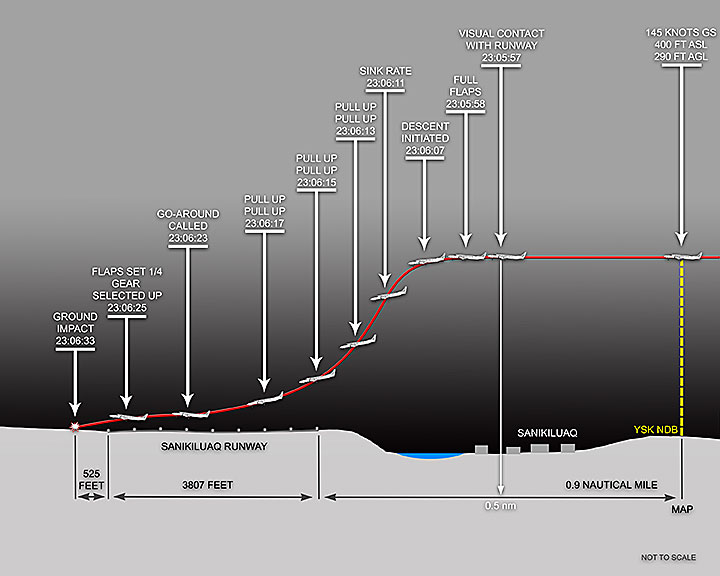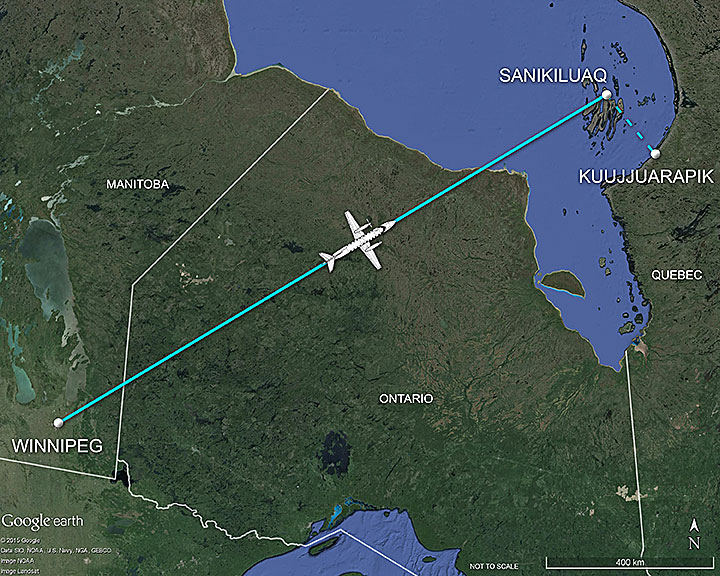Low-energy rejected landing and collision with terrain
Perimeter Aviation LP
Fairchild SA227-AC Metro III, C-GFWX
Sanikiluaq, Nunavut
The occurrence
Perimeter Aviation Flight 993 was originally scheduled to depart Winnipeg, Manitoba, for Sanikiluaq, Nunavut, on the morning of December 22, 2012, but several issues, including repairs to the cargo door, caused a four-hour delay. After finally taking off, the crew realized they'd forgotten key published information for the approach and landing at Sanikiluaq. Rather than return to Winnipeg and lengthen the flight, the captain radioed the company to obtain most of the required information.
The crew's initial plan was to come in on a straight-in visual approach to land eastbound, into the wind on Runway 09 at Sanikiluaq. Weather conditions, however, did not permit this. As there was no published instrument approach procedure for Runway 09, they used the published procedure for Runway 27 and circled around visually to land on Runway 09, as wind favored landing in that direction. But visibility was insufficient, so they circled a second time, only to once more lose sight of the runway.
En route, a weather update had revealed that the alternate destination of Kuujjuarapik was no longer feasible. Since the weather was still technically acceptable for landing, the crew decided to continue attempting to land at Sanikiluaq. With the crew feeling increasing pressure to land, there was an increase in stress, workload, frustration and fatigue, resulting in attentional narrowing and a breakdown in crew communication. They made a second attempt, this time to land westbound on Runway 27. A tailwind, however, increased the aircraft's groundspeed, and they came in too high, too steep, and too fast, sighting the runway later than expected. By the time the captain decided to reject the landing it was too late, and the aircraft struck the ground. This is considered an approach-and-landing accident.
Safety communication
Recommendations
TSB Recommendation A15-01: The Board recommends that the Department of Transport require commercial air carriers to collect and report, on a routine basis, the number of infants (under 2 years old), including lap-held, and young children (2 to 12 years old) travelling.
TSB Recommendation A15-02: The Board recommends that the Department of Transport work with industry to develop age- and size-appropriate child restraint systems for infants and young children travelling on commercial aircraft, and mandate their use to provide an equivalent level of safety compared to adults.
Media materials
News release
December 2012 accident in Sanikiluaq, Nunavut, highlights need for improved safety for infants and children onboard aircraft
Read the news release
Deployment notice
TSB is investigating an accident at Sanikiluaq Airport in Nunavut
The Transportation Safety Board of Canada (TSB) is investigating an accident involving Perimeter Aviation's Fairchild Metro 3 C-GFWX, chartered to Keewatin Air, that occurred on 22 December 2012 at Sanikiluaq Airport in Nunavut.
Backgrounders
Speeches
News conference for the release of Aviation Investigation Report A12Q0216: Opening remarks
Kathy Fox, TSB Chair
Gayle Conners, TSB Investigator-in-Charge
Read the opening remarks
Other resources
Information on travelling with young children
- International Civil Aviation Organization: Approval and use of child restraint systems
- Government of Canada: Taking children on a plane
- Transport Canada: Child restraint systems on aircraft, and labelling requirements
- Transport Canada FAQ: Approved child restraint devices for use on aircraft
Investigation information
Download high-resolution photos from the TSB Flickr page.
Class of investigation
This is a class 2 investigation. These investigations are complex and involve several safety issues requiring in-depth analysis. Class 2 investigations, which frequently result in recommendations, are generally completed within 600 days. For more information, see the Policy on Occurrence Classification.
TSB investigation process
There are 3 phases to a TSB investigation
- Field phase: a team of investigators examines the occurrence site and wreckage, interviews witnesses and collects pertinent information.
- Examination and analysis phase: the TSB reviews pertinent records, tests components of the wreckage in the lab, determines the sequence of events and identifies safety deficiencies. When safety deficiencies are suspected or confirmed, the TSB advises the appropriate authority without waiting until publication of the final report.
- Report phase: a confidential draft report is approved by the Board and sent to persons and corporations who are directly concerned by the report. They then have the opportunity to dispute or correct information they believe to be incorrect. The Board considers all representations before approving the final report, which is subsequently released to the public.
For more information, see our Investigation process page.
The TSB is an independent agency that investigates air, marine, pipeline, and rail transportation occurrences. Its sole aim is the advancement of transportation safety. It is not the function of the Board to assign fault or determine civil or criminal liability.
![Damaged Fairchild aircraft [left side] at Sanikiluaq Airport after accident on 22 December 2012. Photo courtesy of the RCMP.](/sites/default/files/eng/enquetes-investigations/aviation/2012/a12q0216/images/a12q0216-photo-01.png)
![Damaged Fairchild aircraft [right side] at Sanikiluaq Airport after accident on 22 December 2012. Photo courtesy of the RCMP.](/sites/default/files/eng/enquetes-investigations/aviation/2012/a12q0216/images/a12q0216-photo-02.png)



